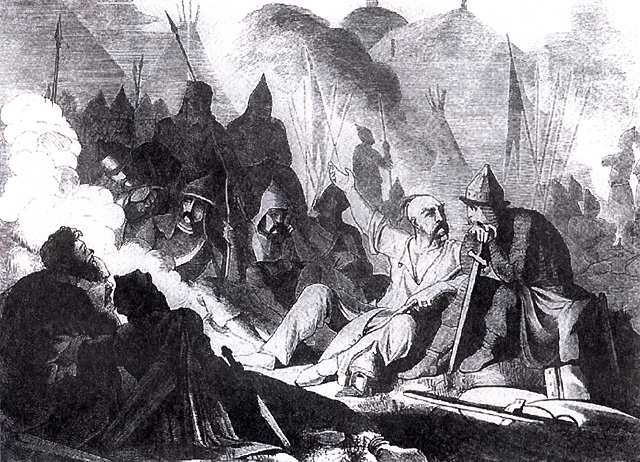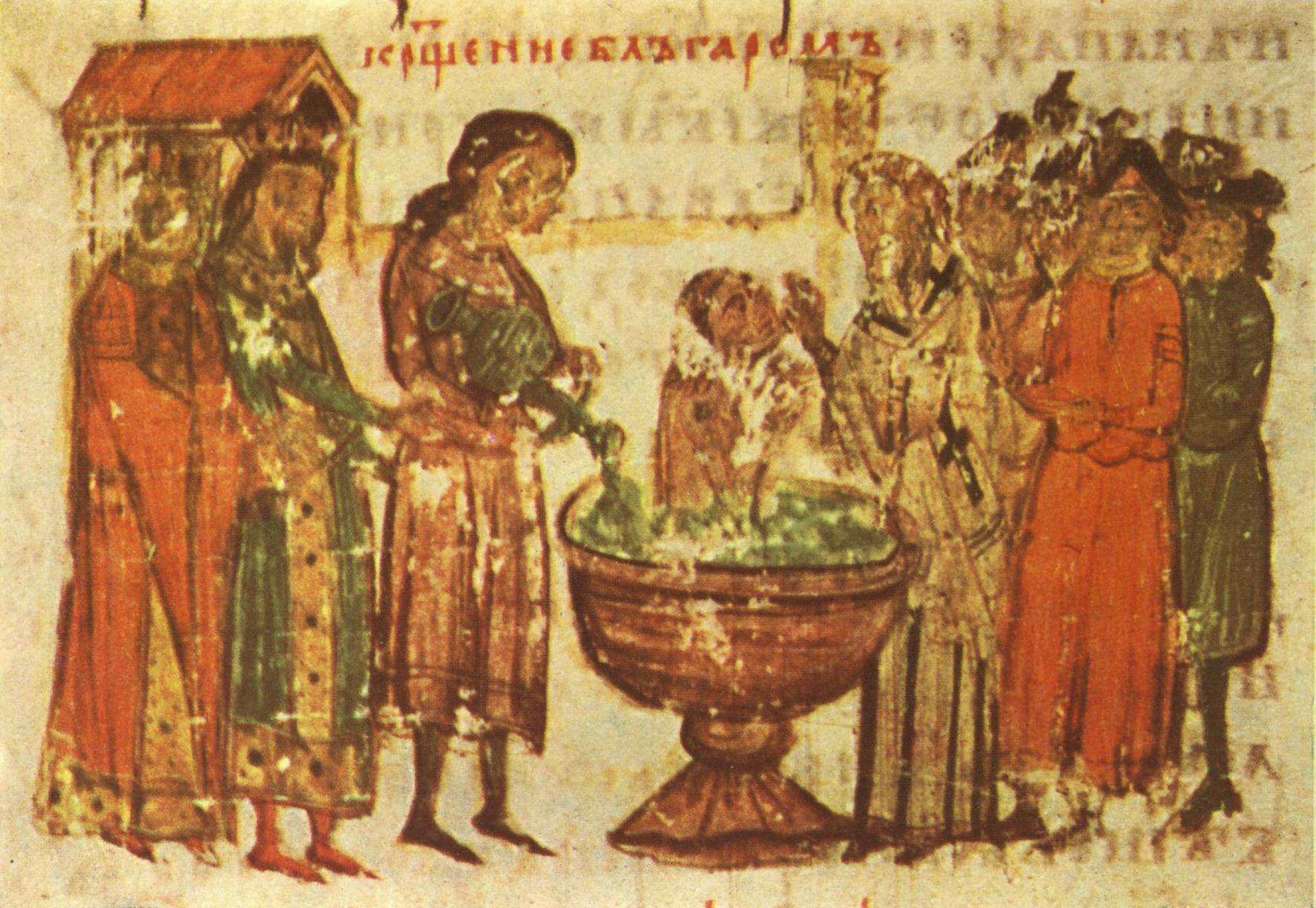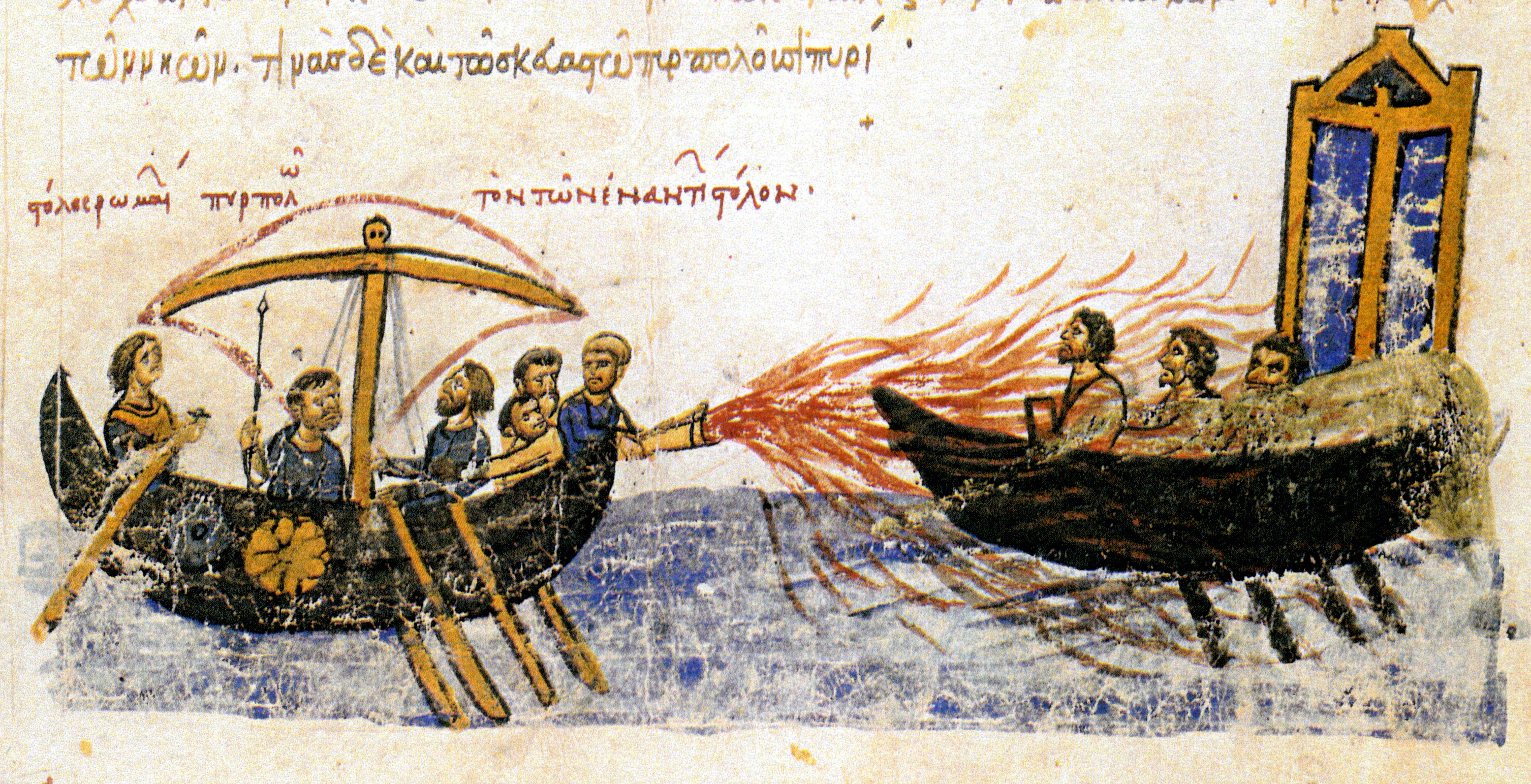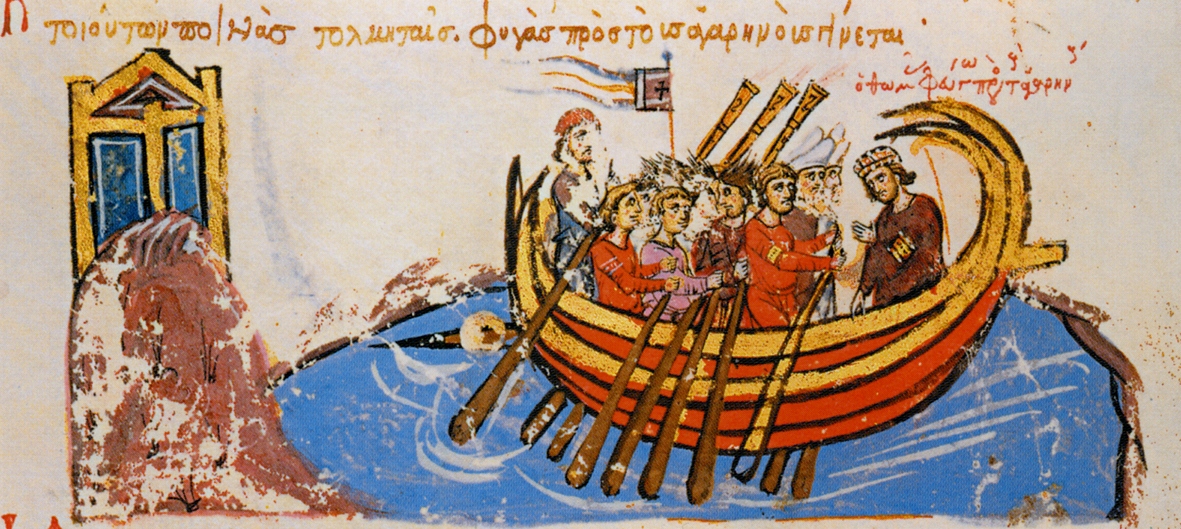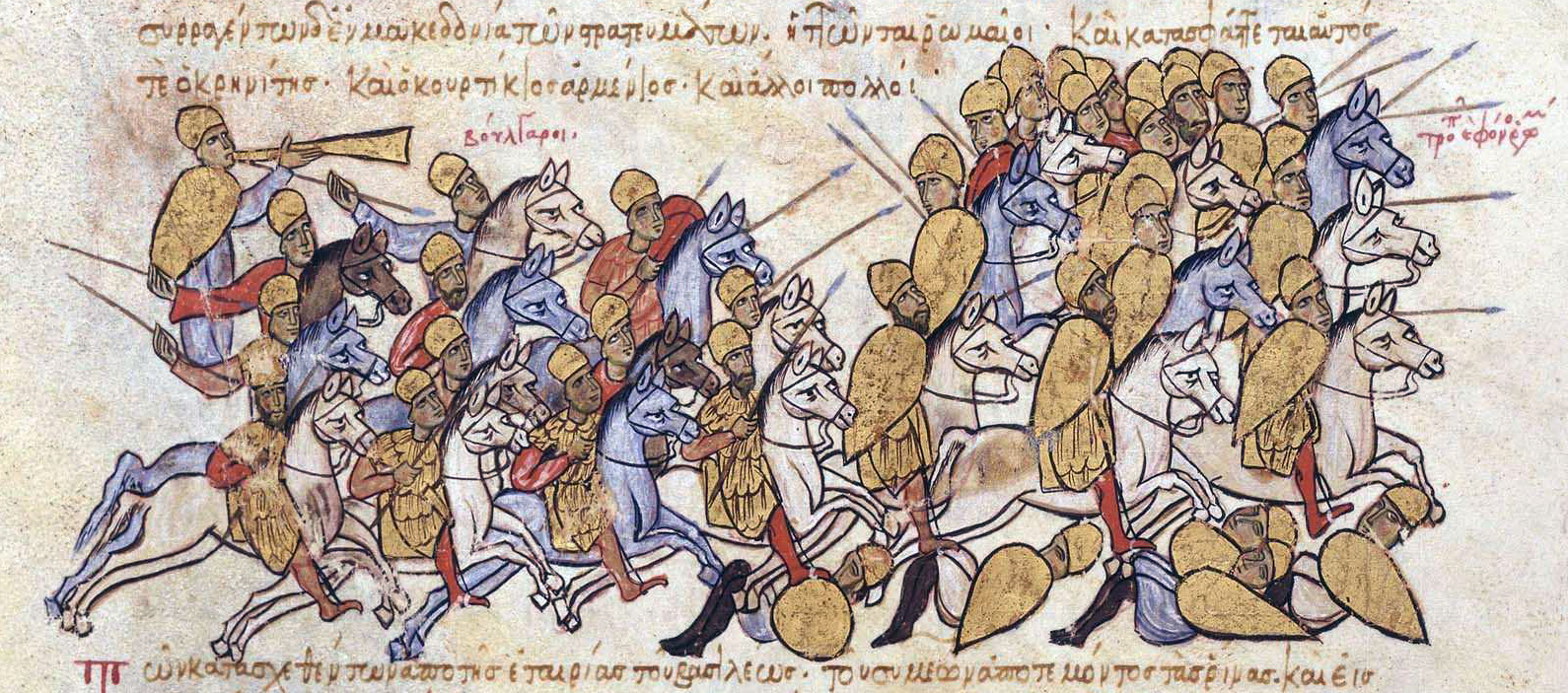|
Skylitzes Chronicle
The ''Madrid Skylitzes'' is a 12th-century illuminated manuscript version of the ''Synopsis of Histories'' () by John Skylitzes, which covers the reigns of the Byzantine emperors from the death of Nicephorus I in 811 to the deposition of Michael VI in 1057. The manuscript was produced at the Norman court of Palermo in Sicily (although there is some debate on whether the main body was made in Palermo or Constantinople) and is now housed in the Biblioteca Nacional de España in Madrid. It remains the only preserved Greek-language illustrated chronicle from the Byzantine period. The chronicle includes 574 miniatures detailing depictions of everyday life in the Byzantine Empire such as boats, literary practices, sieges, and ceremonies, in "both purely Byzantine and Western styles while also reflecting Islamic elements". Evans, Helen C. & Wixom, William D. (1997)''The Glory of Byzantium: Art and Culture of the Middle Byzantine Era, A.D. 843–1261'', p. 438.Metropolitan Museum of Art. ... [...More Info...] [...Related Items...] OR: [Wikipedia] [Google] [Baidu] |
John Skylitzes
John Skylitzes, commonly Latinized as Ioannes Scylitzes (, ; , ; early 1040s – after 1101), was a Byzantine historian of the late 11th century. Life Very little is known about his life. The title of his work records him as a '' kouropalatēs'' and a former ''droungarios'' of the ''Vigla'', whereby he is usually identified with a certain John Thrakesios. His major work is the ''Synopsis of Histories'' ( ), which covers the reigns of the Byzantine emperors from the death of Nikephoros I in 811 to the deposition of Michael VI in 1057; it continues the chronicle of Theophanes the Confessor. There is a continuation of this work, known as ''Scylitzes Continuatus'', covering 1057 to 1079; some historians hypothesize that it was also written by Skylitzes. ''The Madrid Skylitzes'' The most famous manuscript of the ''Synopsis'' was produced in Sicily in the 12th century known as the ''Madrid Skylitzes'' (, ), and is now at the ''Biblioteca Nacional de España'' in Madrid. It f ... [...More Info...] [...Related Items...] OR: [Wikipedia] [Google] [Baidu] |
Islamic Miniature
Islamic miniatures are small paintings on paper, usually book or manuscript illustrations but also sometimes separate artworks, intended for muraqqa albums. The earliest examples date from around 1000, with a flourishing of the artform from around 1200. The field is divided by scholars into four types, Arabic, Persian, Mughal (Indian), Ottoman (Turkish). As in the art history of Europe, "miniature" is generally reserved for images including people, with abstract or geometrical decorative schemes on the pages of books called "illumination". These are much more common, and less sensitive, often found in grand copies of the Quran, as for example in Ottoman illumination. History For a long time, Islamic art from outside the Persianate world was considered aniconic in academic research. Known pictures including human figures from the mileu of Muslim courts have been described as an "aberration" by the early 20th-century writer Sir Thomas Arnold (d. 1930). He asserted that such ... [...More Info...] [...Related Items...] OR: [Wikipedia] [Google] [Baidu] |
Sviatoslav I
Sviatoslav or Svyatoslav I Igorevich (; Old Norse: ''Sveinald''; – 972) was Prince of Kiev from 945 until his death in 972. He is known for his persistent campaigns in the east and south, which precipitated the collapse of two great powers in Eastern Europe, Khazars, Khazaria and the First Bulgarian Empire. He conquered numerous East Slavs, East Slavic tribes, defeated the Alans and attacked the Volga Bulgaria, Volga Bulgars, and at times was allied with the Pechenegs and Hungarian people, Magyars (Hungarians). Following the death of his father Igor of Kiev, Igor in 945, Sviatoslav's mother Olga of Kiev, Olga reigned as regent in Kiev until 962. His decade-long reign over the Kievan Rus' was marked by rapid expansion into the Volga, Volga River valley, the Pontic–Caspian steppe, Pontic steppe, and the Balkans, leading him to carve out for himself the largest state in Europe. In 969, he moved his seat to Pereyaslavets on the Danube. In 970, he appointed his sons Yaropolk I ... [...More Info...] [...Related Items...] OR: [Wikipedia] [Google] [Baidu] |
John I Tzimiskes
John I Tzimiskes (; 925 – 10 January 976) was the senior Byzantine emperor from 969 to 976. An intuitive and successful general who married into the influential Skleros family, he strengthened and expanded the Byzantine Empire to include Thrace and Syria by warring with the Rus' under Sviatoslav I and the Fatimids respectively. Background John was born in present-day Çemişgezek in Tunceli Province. His father, son of Theophilos Kourkouas, was a scion of the Kourkouas family, a clan of Armenian origin that had established itself as one of the chief families among the Anatolian military aristocracy by the early 10th century. His mother belonging to the Phokas family of unknown ethnicity, maybe Greek-Armenian origin. Scholars have speculated that "''Tzimiskes''" was derived either from the Armenian ''Chmushkik'' (Չմշկիկ), meaning "red boot", or from an Armenian word for "short stature", as explained by Leo the Deacon. A more favorable explanation is offered ... [...More Info...] [...Related Items...] OR: [Wikipedia] [Google] [Baidu] |
First Bulgarian Empire
The First Bulgarian Empire (; was a medieval state that existed in Southeastern Europe between the 7th and 11th centuries AD. It was founded in 680–681 after part of the Bulgars, led by Asparuh of Bulgaria, Asparuh, moved south to the northeastern Balkans. There they secured Byzantine Empire, Byzantine recognition of their right to settle south of the Danube by Battle of Ongal, defeatingpossibly with the help of Seven Slavic tribes, local South Slavic tribesthe Byzantine army led by Constantine IV. During the 9th and 10th century, Bulgaria at the height of its power spread from the Danube Bend to the Black Sea and from the Dnieper River to the Adriatic Sea and became an important power in the region competing with the Byzantine Empire. As the state solidified its position in the Balkans, it entered into a centuries-long interaction, sometimes friendly and sometimes hostile, with the Byzantine Empire. Bulgaria emerged as Byzantium's chief antagonist to its north, resulting in ... [...More Info...] [...Related Items...] OR: [Wikipedia] [Google] [Baidu] |
Boris I Of Bulgaria
Boris I (also ''Bogoris''), venerated as Saint Boris I (Mihail) the Baptizer (, ; died 2 May 907), was the ruler (knyaz) of the First Bulgarian Empire from 852 to 889. Despite a number of military setbacks, the reign of Boris I was marked with significant events that shaped History of Bulgaria, Bulgarian and European history. With the Christianization of Bulgaria in 864, paganism was abolished. A skillful diplomat, Boris I successfully exploited the conflict between the Ecumenical Patriarchate of Constantinople, Patriarchate of Constantinople and the Pope, Papacy to secure an Bulgarian Orthodox Church, autocephalous Bulgarian Church, thus dealing with the nobility's concerns about Byzantine interference in Bulgaria's internal affairs. When in 885 the disciples of Saints Cyril and Methodius were banished from Great Moravia, Boris I gave them refuge and provided assistance which saved the Glagolithic and later promoted the development of the Cyrillic script in Preslav and the Sl ... [...More Info...] [...Related Items...] OR: [Wikipedia] [Google] [Baidu] |
Christianization Of Bulgaria
The Christianization of Bulgaria was the process by which 9th-century medieval Bulgaria converted to Christianity. It reflected the need of unity within the religiously divided Bulgarian state as well as the need for equal acceptance on the international stage in Christian Europe. This process was characterized by the shifting political alliances of Boris I of Bulgaria (ruled 852–889) with the kingdom of the East Franks and with the Byzantine Empire, as well as his diplomatic correspondence with the Pope. Because of Bulgaria's strategic position, the churches of both Rome and Constantinople each wanted Bulgaria in their sphere of influence. They regarded Christianization as a means of integrating Slavs into their region. After some overtures to each side, the Khan adopted Christianity from Constantinople in 870. As a result, he achieved his goal of gaining an independent Bulgarian national church and having an archbishop appointed to head it. Background When Khan Boris ... [...More Info...] [...Related Items...] OR: [Wikipedia] [Google] [Baidu] |
Greek Fire
Greek fire was an incendiary weapon system used by the Byzantine Empire from the seventh to the fourteenth centuries. The recipe for Greek fire was a closely-guarded state secret; historians have variously speculated that it was based on saltpeter, sulfur, or quicklime, but most modern scholars agree that it was based on petroleum mixed with resins, comparable in composition to modern napalm. Byzantine sailors would toss grenades loaded with Greek fire onto enemy ships or spray it from tubes. Its ability to burn on water made it an effective and destructive naval incendiary weapon, and rival powers tried unsuccessfully to copy the material. Name Usage of the term "Greek fire" has been general in English and most other languages since the Crusades. Original Byzantine sources called the substance a variety of names, such as "sea fire" (Medieval Greek: ), "Roman fire" ( ), "war fire" ( ), "liquid fire" ( ), "sticky fire" ( ), or "manufactured fire" ( ). History Incendiary and ... [...More Info...] [...Related Items...] OR: [Wikipedia] [Google] [Baidu] |
Basil I
Basil I, nicknamed "the Macedonian" (; 811 – 29 August 886), was List of Byzantine emperors, Byzantine emperor from 867 to 886. Born to a peasant family in Macedonia (theme), Macedonia, he rose to prominence in the imperial court after gaining the favour of Emperor Michael III, whose Eudokia Ingerina, mistress he married on his emperor's orders. In 866, Michael proclaimed him co-emperor. Fearing a loss of influence, Basil orchestrated Michael's assassination the next year and installed himself as sole ruler of the empire. He was the first ruler of the Macedonian dynasty. Despite his humble origins, Basil was an effective and respected monarch. He initiated a complete overhaul of Byzantine law, an effort continued by his successor that ultimately became the ''Basilika''. On the foreign front, he achieved military success against the heretical Paulicianism, Paulicians, whom he subjugated in 872. He also pursued an active policy in the west, allying with Carolingian emperor Louis ... [...More Info...] [...Related Items...] OR: [Wikipedia] [Google] [Baidu] |
Bardas
Bardas (; died 21 April 866) was a Byzantine noble and high-ranking minister. As the brother of Empress Theodora, he rose to high office under Theophilos (. Although sidelined after Theophilos's death by Theodora and Theoktistos, in 855 he engineered Theoktistos's murder and became the ''de facto'' regent for his nephew, Michael III (). Rising to the rank of '' Caesar'', he was the effective ruler of the Byzantine Empire for ten years, a period which saw military success, renewed diplomatic and missionary activity, and an intellectual revival that heralded the Macedonian Renaissance. He was assassinated in 866 at the instigation of Michael III's new favourite, Basil the Macedonian, who a year later would usurp the throne for himself and install his own dynasty on the Byzantine throne. Biography Early life Bardas was born to the '' droungarios'' Marinos and Theoktiste, and was the elder brother of Empress Theodora, the wife of Emperor Theophilos, and of Petronas.. Three o ... [...More Info...] [...Related Items...] OR: [Wikipedia] [Google] [Baidu] |
Thomas The Slav
Thomas the Slav (, – October 823) was a 9th-century Byzantine military commander, most notable for leading a wide-scale revolt in 821–23 against Emperor Michael II the Amorian (). An army officer of Slavic origin from the Pontus region (now north-eastern Turkey), Thomas rose to prominence, along with the future emperors Michael II and Leo V the Armenian (), under the protection of general Bardanes Tourkos. After Bardanes' failed rebellion in 803, Thomas fell into obscurity until Leo V's rise to the throne, when Thomas was raised to a senior military command in central Asia Minor. After the murder of Leo and usurpation of the throne by Michael the Amorian, Thomas revolted, claiming the throne for himself. Thomas quickly secured support from most of the themes (provinces) and troops in Asia Minor, defeated Michael's initial counter-attack and concluded an alliance with the Abbasid Caliphate. After winning over the maritime themes and their ships as well, he crossed wit ... [...More Info...] [...Related Items...] OR: [Wikipedia] [Google] [Baidu] |
Battle Of Boulgarophygon
The Battle of Boulgarophygon (; ) was fought in the summer of 896 near the town of Boulgarophygon (modern Babaeski, Turkey) between the Byzantine Empire and the First Bulgarian Empire. The result was an annihilation of the Byzantine army which determined the Bulgarian victory in the Byzantine–Bulgarian war of 894–896, trade war of 894–896. Despite the initial difficulties in the war against the Magyars, who acted as Byzantine allies, the battle of Boulgarophygon proved to be the first decisive victory of the young and ambitious Bulgarian ruler Simeon I of Bulgaria, Simeon I against the Byzantine Empire. Simeon would go on to inflict a number of defeats on the Byzantines in pursuit of his ultimate goal, the throne in Constantinople. The peace treaty that was signed as a result of the battle confirmed the Bulgarian domination in the Balkans. Background During the rule of Boris I of Bulgaria, Boris I (r. 852–889), Bulgaria underwent major changes – the Christianization o ... [...More Info...] [...Related Items...] OR: [Wikipedia] [Google] [Baidu] |
